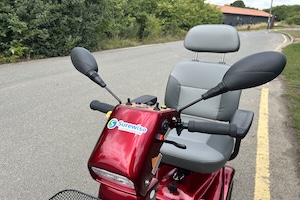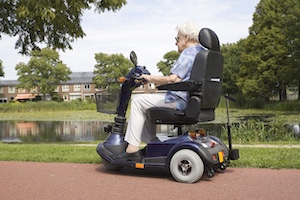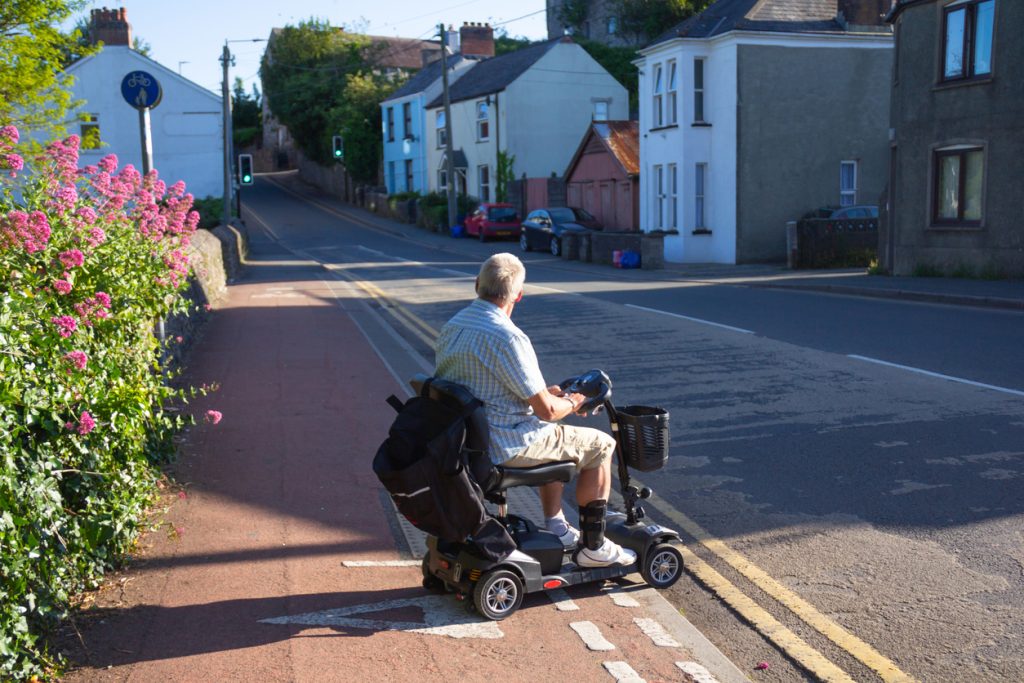As a mobility scooter user, you may have found yourself wondering ‘How long does a mobility scooter battery last?’ and ‘How long does a mobility scooter charge last?’
It’s understandable – knowing both of these things about your scooter battery, and how to look after it correctly, is crucial. Here, we’ll explain everything you need to know about every different type of mobility scooter battery, including how long they last per charge, and how to optimise and extend the lifespan of yours.
How Long Does a Mobility Scooter Battery Last?
The typical lifespan for a mobility scooter is between 12 and 18 months. However, this will vary depending on the type of mobility scooter battery your model uses. With proper care and maintenance, some can last for up to 3-4 years.
There are three main types of mobility scooter batteries; AGM, gel cell, and li-ion. If you’re not sure what type of battery your mobility scooter has, check your manufacturer guide or contact the retailer you purchased your scooter from to check.
Types of Mobility Scooter Battery
Sealed Lead Acid (also known as AGM)
This battery type is best for occasional users, as it produces fewer cycles, meaning it needs to be replaced sooner than the others. This does mean, however, that AGM batteries also tend to be the cheapest option of the three. These types of mobility scooter batteries usually come with a warranty of around one year.
Gel Cell
Gel cell batteries are recommended for more regular users, as they last much longer, with more cycles. You’ll often see gel mobility batteries as the top recommended option – but it’s worth keeping in mind that a higher quality also means a higher upfront cost.
Gel batteries are designed to perform well under varying weather conditions, and tend to ensure more charge cycles than other types of batteries.
Lithium Ion (Li-Ion)
Lithium mobility scooter batteries are an extremely lightweight option, weighing approximately 75% less than standard batteries, which produce many cycles before needing replacement.
They are a great investment for people using their mobility scooter for daily independence, performing very well both in terms of distance and longevity.
Of course, the caveat is that this type of battery is much more expensive than the other two lead-acid options. However, a lithium battery is a great investment, and there are certain things you can do to prolong the life of your battery and keep it at optimal performance, as outlined below.

Mobility Scooter Battery Average Voltage
The majority of mobility scooter batteries are 12v, providing a total of 24v with two battery pairs in the scooter. When you replace your mobility scooter batteries, it is generally recommended that you change the pair together.
Gel cell and AGM batteries are both sealed, so need no maintenance. While AGM batteries are cheaper, gel cell batteries are more suitable for frequent mobility users.
If you have the budget, Li-Ion batteries are a fantastic option, particularly if you are interested in a more lightweight design.
How Long Does a Mobility Scooter Charge Last?
How long the charge of your mobility scooter will last varies, depending on a number of different factors. The most obvious is the type and capacity of the specific battery, but the terrain where the scooter is used, the average speed it is used at, and extreme weather conditions can also have an effect.
An average battery will last around one hour, but heavy-duty scooters can last upwards of eight hours.
How Far Can a Mobility Scooter Go In One Charge?
How far a mobility scooter can go in one charge will also depend on the same kinds of varying factors. Most will come with a manufacturer-recommended range, but, on average, can go between 10 and 30 miles.
How Long Should I Charge My Mobility Scooter For?
There’s no one-size-fits-all answer to how long you should charge your mobility scooter for, as it will depend on the size of the battery included. For that reason, it’s important to always check the manual of your specific model.
How to Extend Your Mobility Scooter’s Battery Lifespan
You can ensure you get the most from your battery before needing to replace it.
Charging
Most mobility scooter manufacturers recommend charging your scooter before and after use. It’s always a good idea to check with your specific manufacturer, but the general guidelines are:
- Charge your scooter after every trip to ensure it is ready to go for next time
- Avoid ever letting the battery fully discharge
- If you haven’t used your scooter in a while, charge it at least once a month to avoid it going flat
- Always use the charger provided by the manufacturer
- Avoid leaving your scooter charging overnight or for long periods of time- overcharging can lead to fires in some cases
Storage
Storing your scooter correctly can lengthen the lifespan of your battery. Ideally, you should store your scooter and charger in a cool and dry place, preferably indoors and away from extreme temperatures or moisture. Read more about how to safely store your mobility scooter.
If you have any queries about storing your lithium scooter battery, you can contact your manufacturer or a local repair shop.
Maintenance
It’s a good idea to take your mobility scooter to be serviced once a year. That way, you’ll know the condition your scooter is in, and when you can realistically expect to need to replace your batteries, without any interruption to when or how you use your scooter. This guide to Maintaining Your Mobility Scooter Year Round should give you some great pointers.
To determine whether it’s time for a full battery replacement, look for signs of deterioration, like a significant reduction in range in a single charge, a battery which won’t hold charge, or one that won’t charge at all.
You should also clean your scooter regularly, to remove dust, dirt, and debris, and replace worn-out tyres promptly when necessary.









